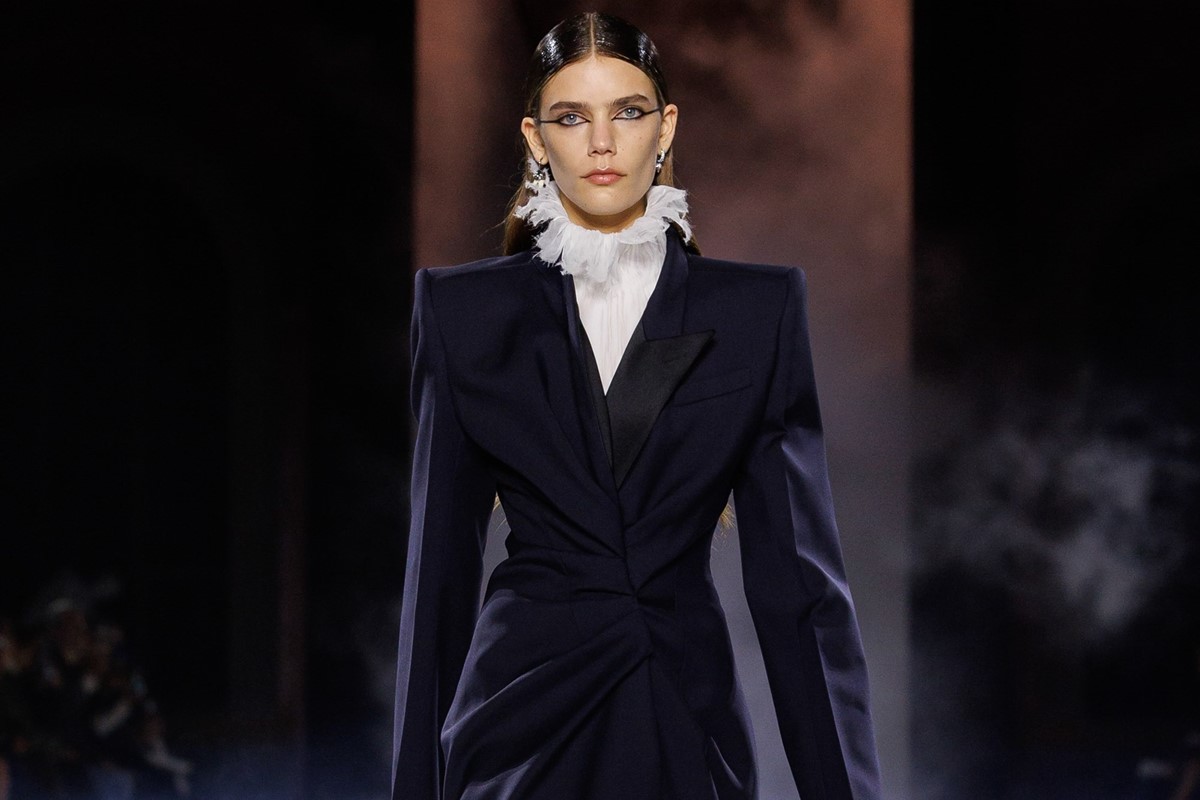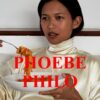
Rewrite
Lead ImageMcQueen Spring/Summer 2025Courtesy of McQueen
In his second show for the house of McQueen, Seán McGirr evidently got his teeth into the archive – one of the most enviable and museum-worthy of all in fashion. He even showed in an echo of Lee Alexander McQueen’s past, at the École nationale supérieure des Beaux-Arts, where McQueen showed his debut haute couture collection for Givenchy (to a critical thrashing, FYI).
That venue was smashed apart and reconfigured by the designer Tom Scutt, as if the 19th century tiles had been torn up with a sluice of steel running through them – something McQueen himself would have probably appreciated. Here are five other archival reflections within the collection:
Early in his career, Lee Alexander McQueen fast gained repute as a master cutter, one constantly twisting and reinventing conventions. Trained on Savile Row, his tailoring was more than perfect, it was ground-breaking – his famed “bumster” trousers, for instance, were an evolution of a tailoring trick to elongate the torso, pushed to a new extreme. For Spring/Summer 1998, McQueen sliced apart the chest of a jacket, inserting transparent tulle to magically suspend the rest as if floating on air – an illusion borrowed by Seán McGirr who trimmed the vent with delicate ruffles.
In the early 2000s, Lee Alexander McQueen’s own label began to show a new delicacy of technique and materials demonstrative of his experience in haute couture. Irere, his Spring/Summer 2003 collection, was based on the dress of the crew of a storm-tossed 17th-century galleon fusing with Amazonian elements. The fine plissé chiffon – first used a season before, in a collection with the unwieldy title Supercalifragilisticexpialidocious, where it was harnessed to the body with leather – was reminiscent of the pleating techniques of Madame Grès, and became a signature of this show, cut into diaphanous ‘shipwreck’ dresses and billowing dandy shirts. McGirr used it for both in his latest collection.
Lee Alexander McQueen was fascinated with fashion histories – the bloodier and more macabre, the better. He was especially enamoured with the mediaeval and Renaissance – he studied tailoring guides from those periods, to imbue his clothes with twisted proportions that nodded to other eras. And the 19th-century serial killer Jack the Ripper – who stalked his victims in the east end, where McQueen grew up and later worked – was a figure of fascination. McQueen’s graduation collection was inspired by him, and the idea of stitching his own hair into the labels of his clothes came from Victorian mounting-jewellery of the same period. In his own second show, Autumn/Winter 1994’s Banshee, the exaggerated tailoring nodded to both the 16th century and to Victoriana – particularly the high-rise highwayman’s collars, which approximated Elizabethan ruffs as well as the stiff ‘stovepipe’ neckwear of Victorian gentlemen. Taking inspiration directly from this collection, Seán McGirr echoed the dramatic neckwear in his own designs.
Highland Rape (Autumn/Winter 1995) proved one of Lee Alexander McQueen’s most controversial collections – its title referred to the violent clearances of Scottish clans by the English, but was misinterpreted by many as referring to the abuse of women when connected with the deliberately tattered and dishevelled clothing on show. However, many McQueen signatures originate in this collection, not least the tattered lace dress, created from a cheap machine lace that McQueen himself sliced portions out of and then superglued the edges to prevent them fraying. 30 years later Seán McGirr executed his tattered laces beautifully, but retained the same idea of mixing the raw and refined in a single garment.
Joan of Arc was a heroine that Lee Alexander McQueen returned to again and again – a female warrior burned at the stake for her beliefs, a Catholic martyr, a symbol of strength and femininity knotted up together, she linked with all his fixations, a connecting thread between his various obsessions. He dedicated his Autumn/Winter 1998 to her, titling it simply Joan. The show culminated with a model in a ring of fire in a glistening red bugle-beaded gown that shrouded her figures including her head – she looked as if she was bathed in blood, but equally as if sporting her own executioner’s hood. That same hood made an appearance on McGirr’s McQueen catwalk, but instead of scarlet she was clad in silver, her figure appearing half armoured, half jewelled deity. Both options were entirely within the grand McQueen tradition.
in HTML format, including tags, to make it appealing and easy to read for Japanese-speaking readers aged 20 to 40 interested in fashion. Organize the content with appropriate headings and subheadings (h1, h2, h3, h4, h5, h6), translating all text, including headings, into Japanese. Retain any existing
tags from
Lead ImageMcQueen Spring/Summer 2025Courtesy of McQueen
In his second show for the house of McQueen, Seán McGirr evidently got his teeth into the archive – one of the most enviable and museum-worthy of all in fashion. He even showed in an echo of Lee Alexander McQueen’s past, at the École nationale supérieure des Beaux-Arts, where McQueen showed his debut haute couture collection for Givenchy (to a critical thrashing, FYI).
That venue was smashed apart and reconfigured by the designer Tom Scutt, as if the 19th century tiles had been torn up with a sluice of steel running through them – something McQueen himself would have probably appreciated. Here are five other archival reflections within the collection:
Early in his career, Lee Alexander McQueen fast gained repute as a master cutter, one constantly twisting and reinventing conventions. Trained on Savile Row, his tailoring was more than perfect, it was ground-breaking – his famed “bumster” trousers, for instance, were an evolution of a tailoring trick to elongate the torso, pushed to a new extreme. For Spring/Summer 1998, McQueen sliced apart the chest of a jacket, inserting transparent tulle to magically suspend the rest as if floating on air – an illusion borrowed by Seán McGirr who trimmed the vent with delicate ruffles.
In the early 2000s, Lee Alexander McQueen’s own label began to show a new delicacy of technique and materials demonstrative of his experience in haute couture. Irere, his Spring/Summer 2003 collection, was based on the dress of the crew of a storm-tossed 17th-century galleon fusing with Amazonian elements. The fine plissé chiffon – first used a season before, in a collection with the unwieldy title Supercalifragilisticexpialidocious, where it was harnessed to the body with leather – was reminiscent of the pleating techniques of Madame Grès, and became a signature of this show, cut into diaphanous ‘shipwreck’ dresses and billowing dandy shirts. McGirr used it for both in his latest collection.
Lee Alexander McQueen was fascinated with fashion histories – the bloodier and more macabre, the better. He was especially enamoured with the mediaeval and Renaissance – he studied tailoring guides from those periods, to imbue his clothes with twisted proportions that nodded to other eras. And the 19th-century serial killer Jack the Ripper – who stalked his victims in the east end, where McQueen grew up and later worked – was a figure of fascination. McQueen’s graduation collection was inspired by him, and the idea of stitching his own hair into the labels of his clothes came from Victorian mounting-jewellery of the same period. In his own second show, Autumn/Winter 1994’s Banshee, the exaggerated tailoring nodded to both the 16th century and to Victoriana – particularly the high-rise highwayman’s collars, which approximated Elizabethan ruffs as well as the stiff ‘stovepipe’ neckwear of Victorian gentlemen. Taking inspiration directly from this collection, Seán McGirr echoed the dramatic neckwear in his own designs.
Highland Rape (Autumn/Winter 1995) proved one of Lee Alexander McQueen’s most controversial collections – its title referred to the violent clearances of Scottish clans by the English, but was misinterpreted by many as referring to the abuse of women when connected with the deliberately tattered and dishevelled clothing on show. However, many McQueen signatures originate in this collection, not least the tattered lace dress, created from a cheap machine lace that McQueen himself sliced portions out of and then superglued the edges to prevent them fraying. 30 years later Seán McGirr executed his tattered laces beautifully, but retained the same idea of mixing the raw and refined in a single garment.
Joan of Arc was a heroine that Lee Alexander McQueen returned to again and again – a female warrior burned at the stake for her beliefs, a Catholic martyr, a symbol of strength and femininity knotted up together, she linked with all his fixations, a connecting thread between his various obsessions. He dedicated his Autumn/Winter 1998 to her, titling it simply Joan. The show culminated with a model in a ring of fire in a glistening red bugle-beaded gown that shrouded her figures including her head – she looked as if she was bathed in blood, but equally as if sporting her own executioner’s hood. That same hood made an appearance on McGirr’s McQueen catwalk, but instead of scarlet she was clad in silver, her figure appearing half armoured, half jewelled deity. Both options were entirely within the grand McQueen tradition.
and integrate them seamlessly into the new content without adding new tags. Ensure the new content is fashion-related, written entirely in Japanese, and approximately 1500 words. Conclude with a “結論” section and a well-formatted “よくある質問” section. Avoid including an introduction or a note explaining the process.


